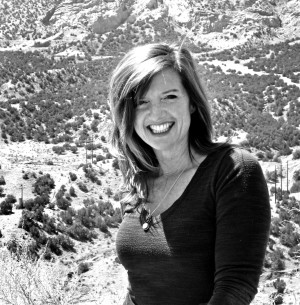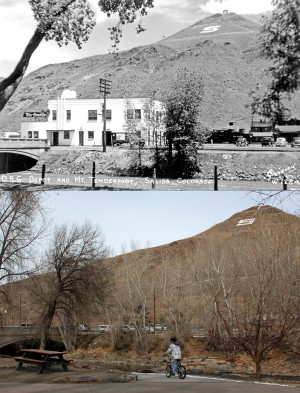By George Sibley
Over here on the west side of Central Colorado, we seem to have achieved another victory over the underlying realities of modern life. The Bureau of Land Management bowed to strong local pressure and called off – for the time being – the leasing of some 20,000 acres of public land in the northwestern part of Gunnison County for oil and gas development. The leases would have permitted drilling in shale for the “tight” oil and gas resources that require “fracking” – pumping chemical cocktails under pressure into horizontal drill holes to fracture the shale and release the oil and gas.
I wrote a letter in support of the campaign to stop the leasing, but it was not a “no way, not now, not ever” kind of letter. My letter reflected (without detailing) my bemused awareness of the fact that, since the beginning of year, I’ve driven from Gunnison twice to the Denver area, once to the Vail Valley area, once to Ouray, flown to Seattle and back, and this coming weekend my partner and I will drive over to Moab for a couple days just for the change of scenery. And then there’s the hundred-plus cubic feet of natural gas that have heated our quaint but still inefficient house. During that time, gasoline prices actually dropped to just under $3.00 per gallon, and natural gas prices are about as low as I’ve ever seen them.
So my letter mainly just asked them to slow down dammit. A lot of the leases marked on the map would have been practically in the back yards of serious farmers in the North Fork valley, and too close to the towns in the valley. I suggested they just do some of the upvalley leases, near existing roads but in places where no one lives, to establish whether the “resource” is there or not, but stop behaving like we really need the stuff when it is still being sold at fire-sale prices. They are no longer the General Land Office, trying to get rid of public lands.
Don’t we all know we are living in la-la land when it comes to actually paying the real costs (plus profits) for our fossil fuels? If we were paying the actual replacement cost of a gallon of gasoline, plus the health and social costs incurred incrementally from the pollutants it puts in our breathing space, plus the costs we are now acknowledging from the several pounds of greenhouse gases it puts in the air – if we were paying those costs at the pump, according to organizations like the International Center for Technology Assessment and the Center for Investigative Reporting, we would be paying $15 a gallon for gasoline. And both of those organizations acknowledge that they have not included the costs associated with – well, call it what you will, protecting or co-opting petroleum resources around the world with the largest military machine the world has ever seen. Our generosity in spreading democracy notwithstanding, how much of the cost of the Iraq and Afghanistan wars should be chalked up to protecting our interests in Middle East oil?
All of those costs are “externalities” that we pay for as taxpayers (whether we benefit from the energy consumed or not) rather than as consumers of the resources. And some of those externalities – notably the rapidly emerging consequences of building up the greenhouse gases in the atmosphere – we are trying to deal with by ignoring, although the “disaster relief” costs for everything from the ongoing drought in our own region to Ma Nature’s assaults on the East Coast are making this harder to ignore. Scientists around the world see these “disasters” as tomorrow’s “new normal.”
Well, $15 gasoline would be a real drag on our persistently shaky economy. But we do need to start thinking about the deeper and more permanent way in which the petroleum that enabled our incredible cultural advances through the 20th century is already becoming a drag on the entire “civilization project” as it becomes harder to find and harder to extract. There is a lot of difference between a resource that comes spurting out of the ground the way it did in Texas and California early in the 20th century, and a resource that has to be accessed far offshore under miles of water muck and rock, or fracked in droplets out of solid rock, or squeezed out of tar sands.
We all need to acquaint ourselves with terms like “net energy” and “EROEI” – not a code name for erotic movies, but the acronym for “Energy Return on Energy Investment.” Energy has to be produced before it can be used – found, harvested, mined, pumped, manufactured, whatever – and the production process requires inputs of energy for all those processes. “Net energy” is the difference between the energy developed through those processes and the energy consumed in the process of producing energy. The EROEI is a ratio derived by dividing the energy developed by the amount of energy invested in developing it. An EROEI of 20:1 means that 20 units of energy are developed for every unit of energy invested in developing it. The best EROEI analyses take as many of the energy-consuming costs into account as possible, from the energy “embedded” in the steel pipes and drills and pumps that produce the crude, to the ships and pipes and machinery that move it to and through the refinery, to the trucks and pipes that deliver the petroleum products to their point of use.
Capitalists and Congressmen can harrumph all they like about needing more men like the “captains of industry” in the late 19th and early 20th century, but what we really need is more domestic sweet crude oil that comes flowing to the surface from shallow wells with an EROEI of 100:1 and huge net-energy gains. Today, thanks to the “miracle” of shale-oil technology, we are once more increasing domestic production, after a peak in conventional production some 40 years ago. But it is not oil and gas with a 100:1 EROEI; it is more like 20:1 over all – the same 100 units get produced, but it takes five times as much energy to produce, refine and distribute them. That is not instantly disastrous to the net-energy flow in society – 95 usable units rather than 99 – but it is a definite tap on the brakes for an industrial society. And without high-EROEI imported oil in the mix, relying primarily on “domestic” deepwater, shale and tar-sand oil, the ratio will drift downward as domestic oil gets more difficult to get to.
You may have seen the “hockey stick” graph for human population – the graph that goes along with a slight uphill climb until around the 19th century, then accelerates upward in a very steep, alarming curve. Energy analysts have a graph that “mirrors” that graph for what they call the “net-energy cliff”: a graph that has a slight downhill run for declining EROEI – until, at around EROEI of 10:1, it plunges downward precipitously. Unlike the “fiscal cliff” melodramas Congress invents for itself, this net-energy cliff is a real one that we are driving toward headlong.
No analyst believes that industrial society as we know it will be possible if the general across-the-board Energy Return on Energy Investment drops to 8:1. And most of our energy resources, other than the fossil fuels, are in the range of 1:1 (ethanol from corn) to 10:1 (nuclear, all the “alternative renewables,” and shale oil once the sweet spots are mined). Hydropower has a nice 30 or 40:1 EROEI, but only accounts for around seven percent of our energy consumption, with all the best hydro locations already taken.
At this point, it is not possible to see how industrial society can be sustained at anywhere near its current levels without continued dependence on the fossil fuels – as long as they last. Richard Heinberg, author of ten books on energy issues, concludes that “there is no clear practical scenario by which we can replace the energy from today’s conventional sources with sufficient energy from alternative sources to sustain industrial society at its present scale of operations.” (“Searching for a Miracle,” 2009 – Google it, and EROEI.) And we are increasingly aware that “today’s conventional sources” of energy are raising hell with our health and the planet’s: every “extreme weather event,” every dry season in the corn belt, every species endangered by ecosystem change, every new iceberg floating south from Greenland is another tap on the brakes; we are very close to having both the gas and brake pedals mashed to the floor as we try to maintain our civilization while also trying to fix it.
The BLM has not abandoned its plan to drill in the North Fork; the plan has just been “deferred”; it will be back, in some small part because I am going to Moab this weekend even though I know better. And there will be drilling plans drawn up for the Upper Gunnison as well, and probably for the rest of Central Colorado; how can we realistically plan for a fossil-free industrial society? Knowing what we know about the impacts of burning fossil fuels, our consumption of them continues to rise barely checked (although we begin to smell the burning brakes).
Meanwhile, time to wrap this up and pack the car for Moab – the desert in winter. Because we still can. Because it’s a way to visit our Southern Rockies future, which ain’t so bad if you like the desert.



